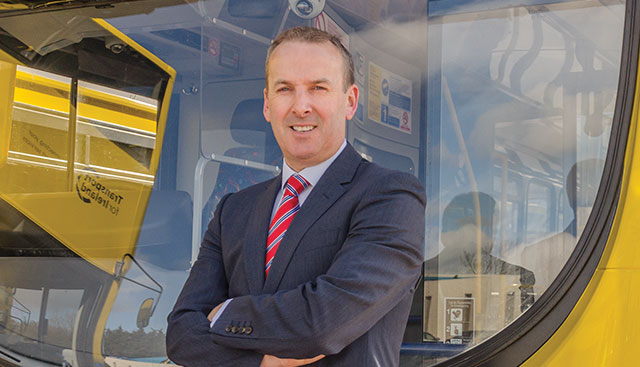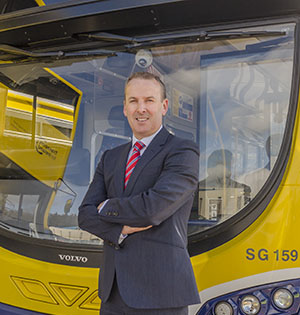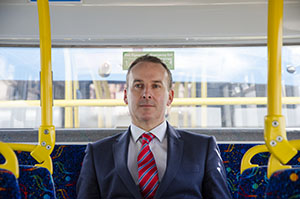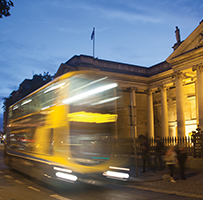Dublin Bus

Dublin Bus Chief Executive Ray Coyne talks to eolas about the growth in customer numbers over the past 18 months and the importance of the bus in attracting people to use public transport.
 The number of customers on buses in Dublin tracks the employment levels in the city very closely. Over the last 18 months there has been a significant improvement in customer numbers on Dublin Bus services. Growth in customer numbers will be 5 per cent this year on top of 3 per cent growth last year, “we haven’t seen figures like that for almost a decade,” observes Ray Coyne, Chief Executive of Dublin Bus. “Last year we carried 122 million customers which is two thirds of all public transport users in Ireland and we have an ambitious target of 25 per cent growth in customer numbers over the next five year period,” he adds.
The number of customers on buses in Dublin tracks the employment levels in the city very closely. Over the last 18 months there has been a significant improvement in customer numbers on Dublin Bus services. Growth in customer numbers will be 5 per cent this year on top of 3 per cent growth last year, “we haven’t seen figures like that for almost a decade,” observes Ray Coyne, Chief Executive of Dublin Bus. “Last year we carried 122 million customers which is two thirds of all public transport users in Ireland and we have an ambitious target of 25 per cent growth in customer numbers over the next five year period,” he adds.
The company’s business includes both public service routes and commercial services. On the public service side of the business the key elements for customers are safety, reliability, frequency of service and the issues of fares and information. “When you get these five things right you are on track to attract larger numbers of customers,” says Coyne.
In addition to delivering on these core elements, Dublin Bus looks to innovate its services. It redesigned its network a number of years ago, which was then the biggest network change in any city in Europe and took two years to implement, between 2010 and 2012. “We redesigned the whole network to meet customers’ needs and demand. In terms of innovation it really shook up our business. We went from a radial network with buses departing from the city centre and going out to the suburbs to a cross-city network whereby buses go from suburb to suburb via the city centre,” comments Coyne.

Growth
A key element of the company’s objectives to grow the business is attracting new customers to their services through initiatives such as improving priority for buses, which will in turn reduce journey times. “The drive towards modal shift is focused on attracting people from the suburbs, particularly at peak travel times, and getting them into the city centre. We are looking to introduce initiatives to significantly improve journey times making the bus a viable alternative to the car. There is a place for the car in the city but with the limited road space available, you have to maximise that space for the most amount of people. We plan to introduce new express services this year that will significantly reduce journey times for customers,” he continues.
The other part of the plan for growth is focused on the company’s commercial services division, where it is the market leader in what is a highly competitive environment. The commercial services division is primarily made up of the city open-top tour business that has been buoyed up by increasing numbers of tourists visiting the city. “It has been a great achievement that we have stayed at the front of that business for 29 years. As in any business, market leaders get imitated and you then have to innovate to keep ahead of the competition. That creates an exciting environment to work in and it also challenges us,” says Coyne. The latest addition to our tours is the introduction of a new 1916 tour which is doing “exceptionally well”. Dublin Bus has partnered with award winning Production Company, Anu, to provide customers with a theatrical experience on the tour bus, which Coyne describes as “theatre on wheels”.
The commercial services business also includes the Airlink 747 service which connects Dublin Airport to the city centre. Since January services on the route have increased by 15 per cent and there are now 200 trips per day. The popularity of the service is due to the fact that it is the cheapest and also the quickest bus service into Dublin City Centre, “we are offering a high quality service at a low price.” In addition to Airlink 747 there are a number of public services operating at Dublin Airport. “There are a range of services operating from Dublin Airport. There is a normal public service route (Route 16) that takes one hour into the city centre and costs €2.60 with Leap Card, and for those wanting to get there quicker there is the Airlink 747 with a €10 return ticket and that takes 25 minutes,” explains Coyne. This summer will see the introduction of a new Airlink route that will operate from the airport via the Port Tunnel to the Camden Street area in the south of the city, with a 30 minute journey time. With both these services there will be a bus leaving Dublin Airport for the city centre every six minutes.
Encouraging public transport use
There are a number of strategic elements to modal shift which is a key element of both Dublin City Council’s vision for the city and The National Transport Authority’s (NTA) “National Transport Strategy 2016 to 2035”. The bus has led the way within Dublin with 122 million journeys last year making Dublin Bus the largest provider of public transport in Ireland. One of the advantages the bus has is that it is very adaptable. The bus can adapt very quickly to changes in demand; “We saw this with the growth over the last 18 months, where we have added additional resources very quickly,” says Coyne. The bus can also work around infrastructure projects or major events, which have become a feature of any modern city. “The bus, being flexible, allows you to service customers with major infrastructure projects such as the LUAS Cross City project or the 1916 centenary commemorations which saw significant changes to bus routes in the city. Over the four days of events we worked with a range of stakeholders and chaired the transport council for all the 1916 events. We were able to facilitate large numbers of people coming into the city,” says Coyne. The flexibility of the bus has always been useful in extreme weather conditions such as flooding and snow, “the bus can adjust its route and still get people to and from work”.
With government looking to invest in public transport, Coyne points out that bus investment is the least capital intensive of public transport modes, “you can get a lot more value for money and can yield results relatively quickly.”
Another benefit he highlights is the fact that you can invest in bus transport to gauge demand before investing in other modes of public transport.
 While the introduction of Quality Bus Corridors (QBC) has been very successful, in order to ensure that all road users are accommodated on our roads new initiatives have to be introduced to deal with the current congestion levels in the city. QBCs have traffic light priority, with technology on the bus changing the traffic signals on approach. This has led to a waiting time reduction of up to 41 per cent at particular junctions. When operating a route that is 10 to 12 km you can get significant time savings. “In addition to a faster journey you get a consistent journey time that doesn’t vary day to day and people can really rely on the bus,” adds Coyne.
While the introduction of Quality Bus Corridors (QBC) has been very successful, in order to ensure that all road users are accommodated on our roads new initiatives have to be introduced to deal with the current congestion levels in the city. QBCs have traffic light priority, with technology on the bus changing the traffic signals on approach. This has led to a waiting time reduction of up to 41 per cent at particular junctions. When operating a route that is 10 to 12 km you can get significant time savings. “In addition to a faster journey you get a consistent journey time that doesn’t vary day to day and people can really rely on the bus,” adds Coyne.
Dublin Bus plays a key role in encouraging people away from private car use and on to public transport but other modes of transport have their part to play also. Cycling has a role as part of the overall transport strategy and has also health benefits for users. There is also a role for car sharing and car pooling and Coyne sees these as very much complementing public transport.
“It is unlikely that roads in the city centre will be widened and therefore traffic management plans must find the best way for all road users to be accommodated in the best way possible.” Dublin Bus has worked closely with Dublin City Council and the NTA on making the most of that space to achieve significant improvements, with schemes such as the contra-flow bus lanes on the Quays which have improved travel times through the city centre. There is also the need for greater multiple public transport offerings to get a bigger modal shift in the future.
Customer engagement
Customer engagement is also a key part of Dublin Bus’s growth strategy over the next five years. The company has introduced a very successful smartphone app which has had over 1.5 million downloads. “The provision of quick and user friendly information is an important part of the customer experience”, says Coyne.
The company has also invested in its fleet over recent years and it now has a modern fleet that is fully accessible. “In 2000 we started to introduce low floor vehicles and then introduced audio announcements to the fleet. We now have a wheelchair and buggy space on each bus.” Dublin Bus has partnered with disability agencies and NGOs such as Age Action Ireland to further improve services for people with disabilities. This includes the introduction of the Travel Assistance scheme, the only such scheme in Ireland. The service is suitable for people with a disability or a mental health issue who may be wary of using public transport. Under the scheme a trained employee comes to the home of the person and helps them re-engage with public transport and it is free for users. “We get great feedback on the scheme with the amount of users taking advantage of the scheme increasing every year” adds Coyne.
DublinBusNews
@dublinbusnews
www.dublinbus.ie






